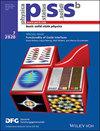Structural Correlation of the Glass‐Forming Ability in a Cu–Zr‐Based Metallic Glass: A Molecular Dynamics Study
IF 1.8
4区 物理与天体物理
Q3 PHYSICS, CONDENSED MATTER
引用次数: 0
Abstract
The Cu–Zr‐based metallic glasses (MGs) have recently sparked great attention due to their outstanding properties and their improved glass‐forming ability (GFA). Therefore, a molecular dynamics study is performed to investigate the effect of composition on the structural analysis methods including the radial distribution function, Voronoi analysis, and coordination number of three Cu‐Zr‐Al alloys to predict the system having the much higher GFA. TheCu-Zr 基金属玻璃中玻璃成型能力的结构相关性:分子动力学研究
最近,Cu-Zr 基金属玻璃 (MGs) 因其出色的性能和更高的玻璃化能力 (GFA) 而受到广泛关注。因此,我们进行了一项分子动力学研究,以探讨成分对三种 Cu-Zr-Al 合金的径向分布函数、Voronoi 分析和配位数等结构分析方法的影响,从而预测具有更高的 GFA 的体系。冷却过程中的 T-V 曲线涉及液态向玻璃态的过渡,表明和是良好的玻璃形成体。研究结果表明,径向分布函数中第二个峰值在处的分叉更为明显。研究还表明,随着铝含量的增加,体系会向氯化萘方向降低。此外,铝含量越高,完整二十面体和扭曲二十面体的含量也越高,因此 GFA 也越高。这些结构展示了各种连接模式,包括顶点共享、边缘共享、面共享和穿透共享,从而产生了更密集的原子堆积。最后,原子组成与结构特性之间存在很强的相关性,这有助于预测更高的 GFA 系统。
本文章由计算机程序翻译,如有差异,请以英文原文为准。
求助全文
约1分钟内获得全文
求助全文
来源期刊
CiteScore
3.30
自引率
6.20%
发文量
321
审稿时长
2 months
期刊介绍:
physica status solidi is devoted to the thorough peer review and the rapid publication of new and important results in all fields of solid state and materials physics, from basic science to applications and devices. Being among the largest and most important international publications, the pss journals publish review articles, letters and original work as well as special issues and conference contributions.
physica status solidi b – basic solid state physics is devoted to topics such as theoretical and experimental investigations of the atomistic and electronic structure of solids in general, phase transitions, electronic and optical properties of low-dimensional, nano-scale, strongly correlated, or disordered systems, superconductivity, magnetism, ferroelectricity etc.

 求助内容:
求助内容: 应助结果提醒方式:
应助结果提醒方式:


